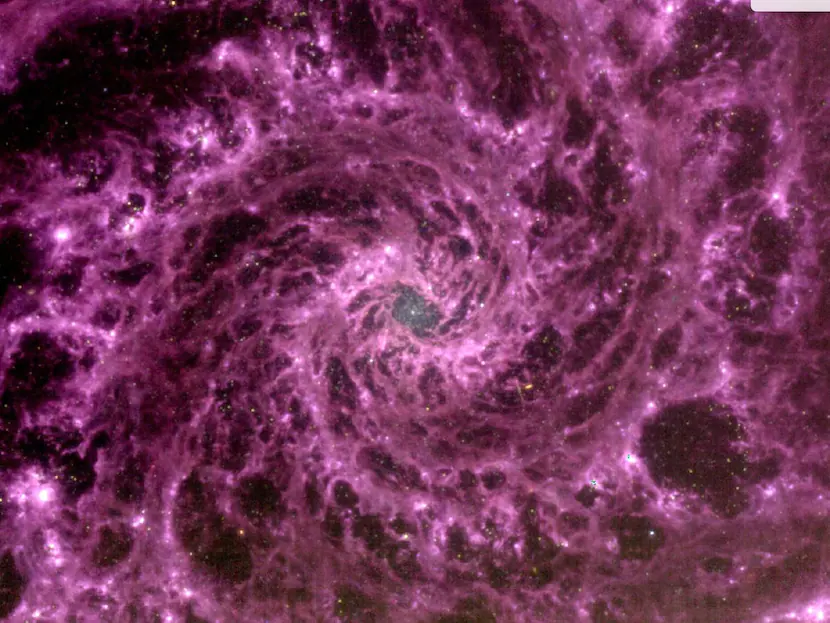[ad_1]
An astronomer has created a breathtakingly beautiful image using data from NASA’s James Webb Space Telescope. It is an image of a ‘purple galaxy’ known as Messier 74 (M74). The galaxy is located 32 million light years away from Earth in the constellation Pisces. It is popularly known as the Phantom Galaxy.
Page Contents
How The Image Of The Phantom Galaxy Was Processed
Gabriel Brammer, an Associate Professor at the Cosmic Dawn Center in the Niels Bohr Institute, University of Copenhagen, made the colour image from the processed data available for free in the Barbara A. Mikulski Archive for Space Telescopes (MAST) portal. The data was already collected by Webb’s Mid-Infrared Instrument (MIRI).
Yes, I made the color image from the processed raw data freely available in the JWST @MAST_News archive
— gbrammer (@gbrammer) July 18, 2022
Brammer compiled the views from three out of nine filters on the instrument.
Brammer translated each of the infrared wavelengths to red, green, and blue, and then combined them to produce one image.
The Phantom galaxy appears like a “whirlpool of purple that radiates counter-clockwise from the galactic centre”, an article published by Inverse said.
The beautiful spiral galaxy M74 is an island universe of about 100 billion stars. It has two prominent spiral arms.
Dr Janice Lee, chief scientist at Gemini Observatory, said on Twitter that “we are drinking from a firehose”.
we are drinking from a firehose… @NASAWebb #phangs @gblancm @karinsandstrom @astrojysun @styrofoamplates @InappTom @GalaxyGroves last galaxy for another month… https://t.co/cEZedwJGMH
— Dr. Janice Lee (@janiceleeastro) July 18, 2022
According to the article, Lee and her fellow researchers gathered the building blocks of the Phantom galaxy as part of the ‘Physics at High Angular resolution in Nearby GalaxieS (PHANGS) survey, which focuses on spiral galaxies. This is because the amount of information spiral galaxies contain about stellar formation is “overwhelming”.
NASA said in a statement that JWST touches on so many different phases of the stellar life cycle, all in “tremendous resolution”.
Allison Kirkpatrick, an expert in supermassive black holes and space dust, posted two pictures of the galaxy on Twitter. One of them was imaged by the Spitzer Space Telescope and the other was captured by the JWST.
Side-by-side comparison of Spitzer/IRAC and JWST/MIRI. This is real and you are completely unprepared*.
Credits below. pic.twitter.com/yqHaIEf7KR
— Prof. Allison Kirkpatrick (@AkAstronomy) July 18, 2022
Undoubtedly, Webb has provided a much more detailed image of the Phantom galaxy, compared to Spitzer.
What Does The Purple Colour Denote?
In another tweet, Brammer wrote that the purple colour cast is actually “real” in the sense that emission from “interstellar cigarette smoke”, which are polyaromatic hydrocarbons, makes the filters used for the blue and red channels brighter relative to green.
According to an article published by New Scientist, the image of NGC 628 is being compared to a Doctor Who vortex. This is a fictional time vortex portrayed in the famous Doctor Who series as a dimensional plane that functionally forms the path between different points in time and space allowing the doctor in the show to travel between them.
Michael Merrifield, a researcher at the University of Nottingham, United Kingdom, said the distinctive purple appearance of Brammer’s image is because of the unique chemical composition of NGC 628’s dust clouds, which are made up of polycyclic aromatic hydrocarbons, according to the article.
Merrifield added that the data could reveal how dust gets made and distributed in galaxies.
Another Image Of The Phantom Galaxy
Astronomers have long admired M74 as a perfect example of a grand-design spiral galaxy.
The JWST has brought the central region of M74 into sharp focus in another image. According to NASA, the colourised combination of image data sets is from two of Webb’s instruments, Near-Infrared Camera (NIRCam) and MIRI. The instruments operate at near- and mid-infrared wavelengths respectively. The image shows cooler stars and dusty structures in the grand-design spiral galaxy.
[ad_2]
Source link
